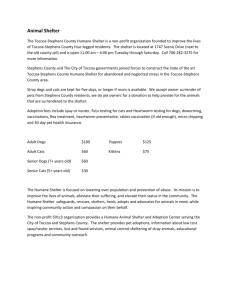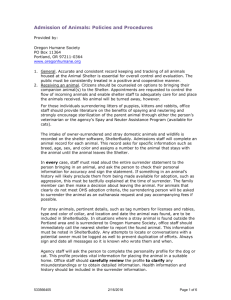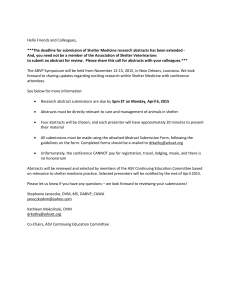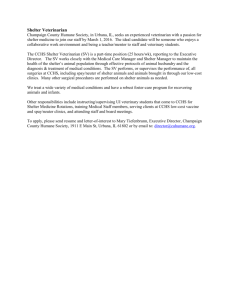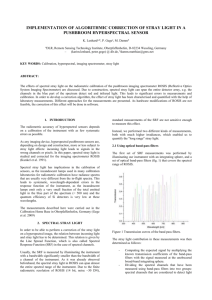Open Selection
advertisement
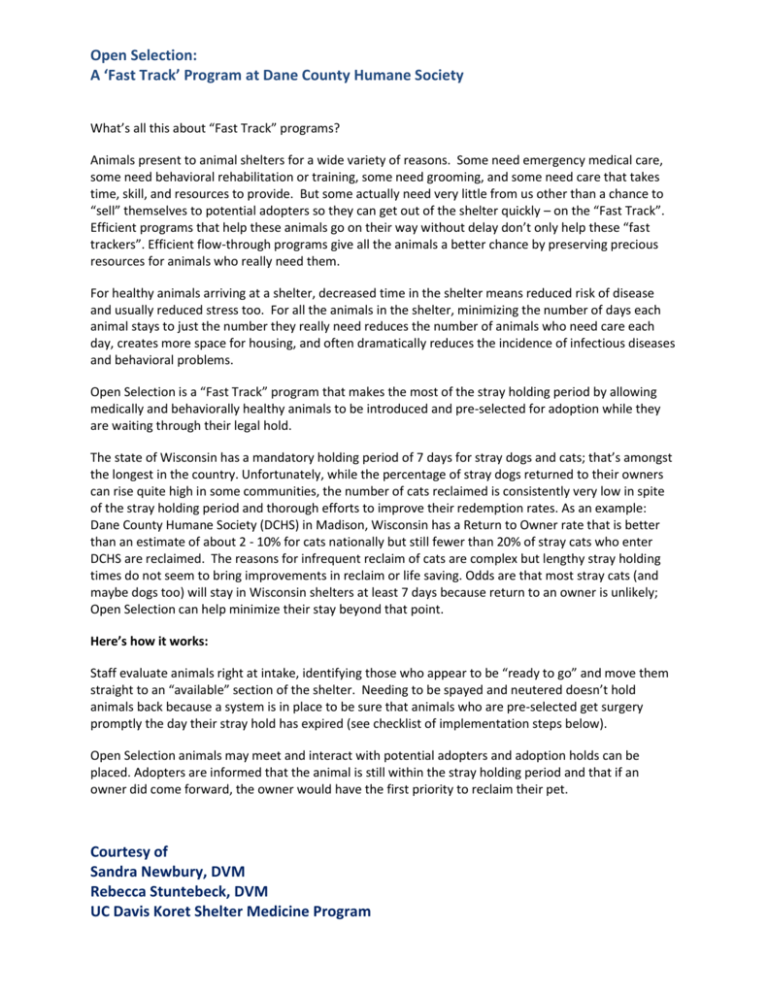
Open Selection: A ‘Fast Track’ Program at Dane County Humane Society What’s all this about “Fast Track” programs? Animals present to animal shelters for a wide variety of reasons. Some need emergency medical care, some need behavioral rehabilitation or training, some need grooming, and some need care that takes time, skill, and resources to provide. But some actually need very little from us other than a chance to “sell” themselves to potential adopters so they can get out of the shelter quickly – on the “Fast Track”. Efficient programs that help these animals go on their way without delay don’t only help these “fast trackers”. Efficient flow-through programs give all the animals a better chance by preserving precious resources for animals who really need them. For healthy animals arriving at a shelter, decreased time in the shelter means reduced risk of disease and usually reduced stress too. For all the animals in the shelter, minimizing the number of days each animal stays to just the number they really need reduces the number of animals who need care each day, creates more space for housing, and often dramatically reduces the incidence of infectious diseases and behavioral problems. Open Selection is a “Fast Track” program that makes the most of the stray holding period by allowing medically and behaviorally healthy animals to be introduced and pre-selected for adoption while they are waiting through their legal hold. The state of Wisconsin has a mandatory holding period of 7 days for stray dogs and cats; that’s amongst the longest in the country. Unfortunately, while the percentage of stray dogs returned to their owners can rise quite high in some communities, the number of cats reclaimed is consistently very low in spite of the stray holding period and thorough efforts to improve their redemption rates. As an example: Dane County Humane Society (DCHS) in Madison, Wisconsin has a Return to Owner rate that is better than an estimate of about 2 - 10% for cats nationally but still fewer than 20% of stray cats who enter DCHS are reclaimed. The reasons for infrequent reclaim of cats are complex but lengthy stray holding times do not seem to bring improvements in reclaim or life saving. Odds are that most stray cats (and maybe dogs too) will stay in Wisconsin shelters at least 7 days because return to an owner is unlikely; Open Selection can help minimize their stay beyond that point. Here’s how it works: Staff evaluate animals right at intake, identifying those who appear to be “ready to go” and move them straight to an “available” section of the shelter. Needing to be spayed and neutered doesn’t hold animals back because a system is in place to be sure that animals who are pre-selected get surgery promptly the day their stray hold has expired (see checklist of implementation steps below). Open Selection animals may meet and interact with potential adopters and adoption holds can be placed. Adopters are informed that the animal is still within the stray holding period and that if an owner did come forward, the owner would have the first priority to reclaim their pet. Courtesy of Sandra Newbury, DVM Rebecca Stuntebeck, DVM UC Davis Koret Shelter Medicine Program Open Selection: A ‘Fast Track’ Program at Dane County Humane Society If an owner comes to reclaim their lost pet, great! If no owner comes forward the animal is given priority for spay/neuter slots and sent home the same day its stray period expires. Open Selection can be used for dogs or cats, though at DCHS, because so many stray dogs are reclaimed within the first few days, it is used exclusively for cats. Checklist for using Open Selection: Setting up for Open Selection 1. Evaluate average LOS for stray animals, especially for animals who seem like they are easy to place – highly desirable 2. Calculate or estimate the percent of strays likely to be returned to owner 3. Consider break down of space within the shelter. How much of the housing space is non-public 4. Establish a stage or status for animals who will be available for pre-selection but are still in their stray holding period 5. Establish a priority system for selection: (example) a. Citizens b. Rescues c. Volunteers d. Staff For some shelters, where providing spay neuter without delay is a challenge; it may make the most sense to give rescue groups the priority 6. 7. 8. 9. 10. 11. 12. Establish a stage or status for animals who have been pre-selected Evaluate spay / neuter capacity Establish a system for prioritizing post-selection surgery Consider adoption processing capacity Establish a system to ensure adoptions will be processed efficiently Write a protocol Train staff to perform a thorough physical exam, provide intake treatments such as vaccination, and briefly evaluate behavior at intake. 13. Train staff to coordinate departments and implement protocols Putting the plan into action: 1. Check microchips, ID tags and lost reports to provide every stray animal the best chance of being returned to an owner. 2. If no concerns or evidence of owners / guardians are evident, make the animal available for Open Selection. 3. Move Open Selection candidates to the adoption area; 4. Database and paper records should make it clear that the animal is still a stray and may be reclaimed by owner within the legal holding period. Courtesy of Sandra Newbury, DVM Rebecca Stuntebeck, DVM UC Davis Koret Shelter Medicine Program Open Selection: A ‘Fast Track’ Program at Dane County Humane Society 5. Perform daily rounds to account for the status of each animal in the shelter; this will ensure that any animal (Open Selection or otherwise) with an adoption hold has the opportunity to be spayed or neutered and leave the shelter as soon as possible, in addition to providing other benefits to overall population management. Courtesy of Sandra Newbury, DVM Rebecca Stuntebeck, DVM UC Davis Koret Shelter Medicine Program
